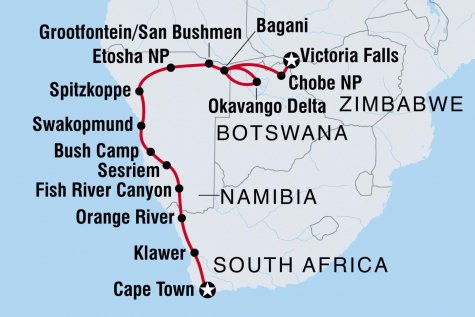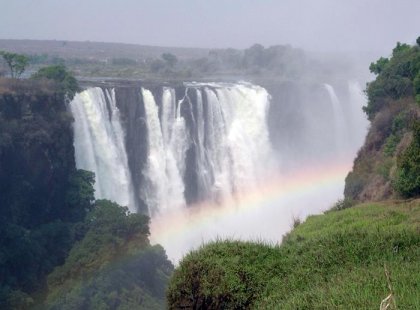Vic Falls to Cape Town
22 days
From
$ 2436
Duration22 days
Explore the contrasting lands of southern Africa. Experience the extremes of southern Africa's landscapes on this journey from the thunderous Victoria Falls to cosmopolitan Cape Town. Travel down lush waterways in the enigmatic Okavango Delta, cruise past elephants and birds on the Chobe River, climb giant sand dunes in Namibia, camp to the sounds of Africa's wildlife and spot big cats, rhinos, zebras and antelopes on Etosha National Park's arid plains. Visit the people who make their homes here, from cheerful delta mokoro polers to the San people. Get ready for this unforgettable tour through a land of contrasts.
-
Duration: 22 daysService level: Basic
-
Starts in: Princess Victoria IslandPhysical Grading: Light
-
Ages: 15+

Itinerary
Day 1: Victoria Falls
Start place: Princess Victoria Island
Mhoro! Welcome to Zimbabwe. Your adventure begins with a welcome meeting at 4 pm where you'll meet your tour leader and fellow travellers. You can arrive at any time as there are no activities planned until this important meeting. Please ask the hotel reception where it will take place. If you can't arrange a flight that will arrive in time for this, consider arriving a day early so you are able to attend. If you are going to be late, please inform the hotel reception. We'll be collecting your insurance details and next of kin information at this meeting. Those who arrive early can choose from many optional activities and sights to see around Victoria Falls. Upgraded accommodation is available – please ask at reception or speak to your leader. Wi-Fi is also available.
Your leader will take you to a local activity centre where a range of activities will be on offer. We have not risk assessed all activities and only those listed in our trip notes are recommended. It is against company policy for leaders to facilitate the booking of any activities that have not been risk assessed or do not adhere to our company’s Responsible Travel policy and ethos. This includes organising transport to and from these activities in our vehicles.
Your leader will take you to a local activity centre where a range of activities will be on offer. We have not risk assessed all activities and only those listed in our trip notes are recommended. It is against company policy for leaders to facilitate the booking of any activities that have not been risk assessed or do not adhere to our company’s Responsible Travel policy and ethos. This includes organising transport to and from these activities in our vehicles.
Day 2: Victoria Falls
Today you have the option of visiting the magnificent Victoria Falls. Spanning about a mile wide and falling 108 metres into a narrow gorge below, the spray from the falls can sometimes be seen from kilometres away. In the dry season, the view of the falls is unobstructed by spray and it's possible to see little islets in the river below. To fully understand the sheer force of this staggering curtain of water, it needs to be experienced in person. It's no wonder that the local name Mosi oa Tunya means the 'smoke that thunders'. Otherwise, a range of other activities are available through the local activity centre. Please keep in mind that we have not risk assessed all activities and only those listed in our trip notes are recommended. It is against company policy for leaders to facilitate the booking of any activities that have not been risk assessed or do not adhere to our company’s Responsible Travel policy and ethos. This includes organising transport to and from these activities in our vehicles.
Meals: B
Day 3: Chobe National Park
This morning is free for you to continue enjoying all that Victoria Falls has to offer. Afterwards, travel to Chobe National Park in Botswana (approximately 2–3 hours) via the Victoria Falls Wildlife Trust, one of The Intrepid Foundation projects. Here you can learn about the rescue and rehabilitation of wildlife, human-wildlife conflict and the trusts role in anti-poaching. There may also be a chance to meet any rescued or orphaned wildlife currently in their care.
Botswana's first national park is famous for its high concentration of elephants, so keep an eye out for them. They can often be seen swimming in the Chobe River. Your camp, located outside of the park, has flush toilets, showers, Wi-Fi, ATM and optional upgrades.
Botswana's first national park is famous for its high concentration of elephants, so keep an eye out for them. They can often be seen swimming in the Chobe River. Your camp, located outside of the park, has flush toilets, showers, Wi-Fi, ATM and optional upgrades.
Meals: B, D
Day 4: Chobe National Park
Enjoy an early-morning game drive. Adventuring through the park, you will have the opportunity to get up close to the wildlife. With some luck you will spot a variety of animals and any number of exotic birds. As well as the Chobe icon, the elephant, the river also attracts hippos and crocodiles; the latter like to sun themselves by the water's edge. Cheetahs also come down for a drink. The birdwatching is excellent here too – look out for eagles, kingfishers and marabou storks, among hundreds of other species. In the afternoon perhaps take an optional cruise down the Chobe River – one of the best ways to enjoy the park's animals.
Meals: B, L, D
Day 5: Bagani
Today you will enter Namibia, driving from Kasane to Ngoma Bridge, and on to your camp at Bagani (approximately 7 hours). Bagani is a small, friendly town with some good hiking trails along the river. There are also plenty of nice spots in which you can simply relax and soak up the ambience. This area is the homestead of the local Mbukushu kings. You will have the opportunity to stop at an ATM and a market or shop today. Your camp has flush toilets, showers and Wi-Fi. Upgrades are also available (subject to availability).
Meals: B, L, D
Day 6: Okavango Delta
Drive across the border into Botswana and head south along the Okavango Panhandle (the narrowest part of the delta) to Seronga. Here you'll leave your vehicle and join your transport for the journey into the delta (approximately 4 hours). Take a boat across the swamps to Gao Island to meet your mokoro team and start exploring the Okavango Delta with them. Each mokoro (small dugout canoe) takes two people and is poled along through the waterways by a local tribesman. Reeds and lily pads line the streams, and birds startled by the mokoros rise out of the long grasses. Punting along, you'll hear hippos occasionally piercing the peaceful atmosphere with their grunts. On the first night here you'll camp on an island well away from civilisation.
Meals: B, L, D
Day 7: Okavango Delta
Continue your trip around the delta and then return to Gao Island before heading to the relative civilisation of Umvuvu Camp. This camp usually has hot showers, and there's a small bar at which you can relax and perhaps enjoy a refreshing sundowner. Today there is an option to take a nature walk with your guide. This is a great chance to discover the beautiful natural surrounds, gain some insight into the history of the local area and take some photos.
Meals: B, L, D
Day 8: Bagani
Return to Bagani to camp for the night. Various boat trips, fishing trips and guided hikes are possible from Bagani, so if you're feeling active, get out and make the most of it. Those who are feeling bold might even be able to challenge the local kids to a soccer match – don't expect to win though! Retire to your camp in the evening and enjoy this welcome break from the road.
Meals: B, L, D
Day 9: Grootfontein
Drive to your camp situated 50km outside Grootfontein (approximately 7 hours). The town of Grootfontein, part of the Otavi Triangle, tends to get very green in the warmer months but dries out markedly in the winter. If it's springtime, you'll likely see jacarandas in bloom. There is the possibility of an accommodation upgrade here, but wi-fi will not be available.
Meals: B, D
Day 10: Grootfontein/San people
Embark on a 180-kilometre (112-mile) round-trip to visit the San people. The oldest inhabitants of Southern Africa, the San have lived in this region for at least 20,000 years. Listen to their stories and songs, and learn how those who still adhere to a traditional way of life emphasise the important of living in harmony with the environment.
Meals: B, L, D
Day 11: Etosha National Park
Travel about five hours to Etosha National Park. The park is home to a wide range of Southern Africa's wildlife, including all the big carnivores and five rare or endangered species: black rhino, Hartmann's mountain zebra, black-faced impala, roan antelope and the tiny Damara dik-dik. Game viewing in Etosha is relatively easy due to the man-made waterholes and the large, sparsely vegetated pans. The bushland surrounding the pans is difficult to see through, but there are enough clearings, pans and waterholes to usually allow for some sightings. Embark on an optional evening game drive here in the evening, then spend the night at Namutoni. Accommodation upgrades are on offer here.
Meals: B, D
Day 12: Etosha National Park
Enjoy a full-day game drive in Etosha National Park. Namibia has protected its game reserves against poaching, which means significant numbers of elephants, antelope and other herbivores reside here. The park is also home to some 340 species of birds – keep an eye to the sky where you might spot a soaring eagle. Tonight you will stay at the particularly spectacular Okaukuejo Camp. The camp overlooks a floodlit waterhole visited by many different species throughout the day and night. Upgrades are not available at this location tonight.
Meals: B, L, D
Day 13: Spitzkoppe
Travel to the mountain of Spitzkoppe, the 'Matterhorn of Namibia' (approximately 9 hours). The wild lands around this superb granite peak are some of Namibia's most stunning. The mountain itself is 700 million years old and 1987 metres/6519 feet high. Although you shouldn't try to climb to the top, there are some excellent hikes to do in the area, which is rich in plant life and has some bush paintings to be found. Be sure to look out for the sunset from your bush camp this evening – the landscape is known to take on dazzling hues of orange and red.
Meals: B, L, D
Day 14: Swakopmund
Continue to the town of Swakopmund (approximately 5-6 hours). Be dazzled by the sight, sound and smell of thousands of olive-coloured seals on the shores of Cape Cross while you're travelling up the eerie Atlantic Coast. You'll be able to stop along the way to access an ATM or market if you need some supplies. Your accommodation for these nights is a simple, cosy lodge. Wi-Fi is not available at this location.
Meals: B, L
Day 15: Swakopmund
Surrounded by the massive dune fields of the Namib Desert on three sides, and the Atlantic Ocean on the other, Swakopmund is an example of the extraordinary German culture that's found in all major settlements in Namibia. It's worth wandering around town to admire the beauty of the Germanic architecture and take advantage of some excellent souvenir shopping.
Day 16: Swakopmund
Today is another free day to enjoy this fun beachside town. If you're after a dose of history and culture, you can stop in at the lighthouse and visit the Swakopmund Museum. Active types and thrill-seekers might like to take advantage of the many outdoor activities on offer – this town is the adventure-sports mecca of Namibia.
Day 17: Sesriem
Drive to Sesriem, your base for exploring the incredible Namib Desert region (approximately 6-7 hours). The most famous part of the Namib Desert is its vast dune fields, the most spectacular of which are found near the Sesriem Canyon. This canyon was formed when the Tsauchab River carved a gorge 30 metres into the gravel deposits about 15 million years ago. Now the river flows out to the dune fields that stretch for hundreds of miles up the coast, and dries up in a clay pan at Sossusvlei. The dunes are stunning, with magnificent burning tones created by the brightly coloured sands. These are the highest dunes in the world.
Meals: B, L, D
Day 18: Sossusvlei / Konkiep River
Wake up before dawn and scramble to the top of the dunes for a dramatic sunrise view across a vast sea of sand. The colour changes are simply incredible and provide a spectacular setting for your brunch. Afterwards you will jump in the back of a pickup truck for a trip to Sossusvlei, the incredible salt and clay pan just nearby (approximately 30 minutes each way). Enjoy some time to explore this incredible and mysterious desert oddity. Later, continue to your camp past the small town of Bethanie (approximately 6 hours). Your camp has basic facilities, with showers, flush toilets, Wi-Fi and optional upgrades.
Meals: B, L, D
Day 19: Fish River Canyon
Check out the town of Bethanie before heading further south, deeper into the vast desert lands of Namibia, drive towards Fish River Canyon (approximately 3-4 hours). At 500 metres deep and over 160 kilometres long, Fish River Canyon is one of the very largest canyons in the world. During the dry season, the river bed tends to dry out completely, leaving only a few puddles. In the wet season, after the summer rains, the river can turn into a spectacular raging torrent. At any time of year there are remarkable photographic opportunities here as we watch the color of the granite rocks change as the sun goes down. Note that upgrades and Wi-Fi are not available at your camp tonight.
Meals: B, L, D
Day 20: Orange River
Departing Fish River Canyon, travel to Noordoewer (approximately 5 hours). Pitch your tent on the scenic banks of the Gariep (Orange) River. Traditionally known as the Gariep River, the Orange River is the longest in South Africa, at 2200 kilometres/1367 miles. Its source is high up in the Drakensberg mountain range in Lesotho, and it flows into the Atlantic Ocean at Alexander Bay in South Africa. The Orange River is responsible for transporting diamonds and creating the deposits that can be found along the Namibian coast. Upgrades are possible tonight (subject to availability), though there is no Wi-Fi available.
Meals: B, L, D
Day 21: Western Cape
Depart first thing in the morning, heading to Klawer – a town named after the Afrikaans word for a wild clover blooming after rainfall. The surrounding countryside is beautiful. If there's time, you will have the opportunity to explore some of it – take a delightful walk around the nearby mountains and farms before retiring for the evening.
Meals: B, D
Day 22: Cape Town
Head to Cape Town (approximately 5 hours), where you trip ends upon arrival. With its stunning coastline, modern cityscape, nearby mountains and a plethora of nearby vineyards, this is one of Africa's most exciting cities. There's no accommodation provided for tonight, but this can be arranged – please enquire at the time of booking this trip.
Meals: B
Inclusions
Included
- Victoria Falls - Victoria Falls Wildlife Trust Visit
- Chobe National Park - Dawn 4x4 game drive
- Okavango Delta - Mokoro safari
- Okavango Delta - Nature Walk
- Grootfontein - San Bushman cultural experience
- Etosha National Park - Overland Vehicle Game Drive
- Cape Cross Nature Reserve - Cape Cross seal colony
- Sossusvlei - 4x4 Tour
- Sesriem - Sand dunes visit
- Fish River Canyon - Canyon entrance
-
Transport
Overland vehicle, 4x4 Safari Vehicle, Mokoro -
Accommodation
Camping (with basic facilities) (2 nights), Camping (with facilities) (16 nights), Cabin (3 nights)




